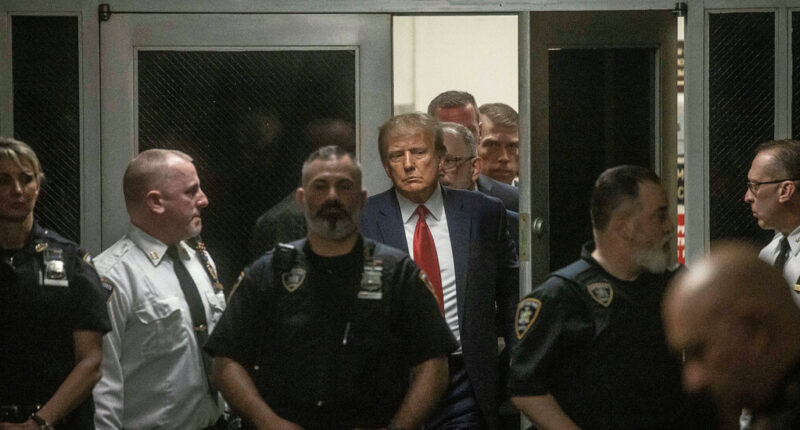
The Manhattan Criminal Courthouse hallway was not the sort of stage that Donald J. Trump would have handpicked for himself.
As tabloid figure, reality-TV star and president, Mr. Trump always paid close attention to his set dressing. With an instinct for the camera, he preferred settings that conveyed grandeur and lent him an aura of power, be they the made-for-TV boardroom of “The Apprentice,” the Trump Tower escalator at his 2015 campaign announcement or the church on Lafayette Square where he held a photo-op after police tear-gassed protesters.
The hallway outside the courtroom where Mr. Trump became the first former president to be criminally indicted was no glitzy platform. The floors were scuffed and the walls drab. The camera focused on a pair of safety-glass double doors, reflecting red “EXIT” signs, through which a glum-looking Mr. Trump passed on his way to his arraignment. The scene was gray, humdrum, municipal, more “Night Court” than Supreme Court. You could practically smell the vending-machine coffee.
The result made visually real what had become a cliché in the case: No one was above the law. Mr. Trump was right there in the law’s nondescript belly (despite the special accommodations that went into his arraignment). In still courtroom images instantly plastered on screens, he sat in the dock like any other defendant, slumped, watched by court guards.
It was an unprecedented sight, a former president being arrested and charged. But as the camera framed him, he was just a guy from Queens waiting to hear from the judge.
Reports before the arraignment said that Mr. Trump planned to speak to the press before entering the courtroom. He did not. Though he had mulled the value of doing a perp walk, there was no such parade. There was no mug shot. There were no handcuffs.
But he was shackled nonetheless: He was for once not at liberty to choose his own scenery. The man who never met a TV camera he couldn’t hog made a quick turn away from it. The man who for the four years of his term had people wondering what would come out of his mouth next kept his lips sealed. The man who practiced the art of media saturation was reduced to a handful of stills and a Grinch-y courtroom sketch.
If the indictment put Mr. Trump in an unfamiliar position, for cable news it was like a trip back in a time machine. Fox News hosts fervently defended Mr. Trump after spending months distancing themselves. Other cable outlets returned to their all-Trump-all-the-time default setting from years ago.
During the 2016 campaign, cable networks aired Mr. Trump’s empty podium before his speeches. On Monday, there were live shots of his plane sitting on a Florida tarmac, taking off and landing in New York, then of his motorcade wending through crosstown traffic, as if rolling up Trump-era and O.J.-era TV excess in one package. On Tuesday, news choppers tracked his drive from Trump Tower to the court building, possibly the most-viewed downtown commute in history.
Ironically, the case that reduced Mr. Trump to a glowering character with no lines was a byproduct of the peak of his TV fame. Stormy Daniels, the porn star whose payoff is at the heart of the investigation, met Mr. Trump during a celebrity golf tournament in 2006, two years after the debut of “The Apprentice” on NBC.
Mr. Trump has denied having sex with Ms. Daniels. But a well-cultivated playboy rep was long part of the persona that he parlayed into reality-TV stardom, which in turn helped give him the visibility (and the carefully produced image as a business leader) to run for president.
According to reports, Mr. Trump and his advisers debated how much of a spectacle to make of his arraignment. (On CNN, Kaitlan Collins reported that he “had expressed some interest in having his mug shot taken”; it didn’t happen, but his 2024 presidential campaign created its own for a fund-raising pitch anyway.) His lawyers ultimately argued against allowing TV cameras into the courtroom.
Mr. Trump, however, has seemingly lived most of his adult life under the premise that if something didn’t happen in front of cameras, it didn’t happen. In the past, his go-to response to any situation in which he might have seemed weak or defeated was to script himself a scene in which he was framed as powerful and a winner.
When he was hospitalized with Covid in October 2020, it was a rare instance in which Mr. Trump had no choice but to appear diminished in public. He set out to fix that, posing at a table with a stack of files in the hospital and choreographing his return to the White House, where he removed his face mask on a balcony. As my colleague Maggie Haberman reported, he considered a plan to unbutton his dress shirt and reveal a Superman logo underneath.
One can only imagine the prop ideas floated this time. (Breakaway handcuffs?) Instead, he returned to his comfort zone — Mar-a-Lago, surrounded by gilded columns, American flags and the MyPillow guy — to run down a Festivus list of grievances to a friendly MAGA crowd.
It was certainly a more pugilistic Mr. Trump than the one who sat in the dock on Tuesday afternoon. But where the arraignment got saturation coverage, only Fox among the major news networks carried the speech beginning to end. As a TV draw, Donald Trump holding court is no competition for Donald Trump sitting in one.
Source: | This article originally belongs to Nytimes.com








